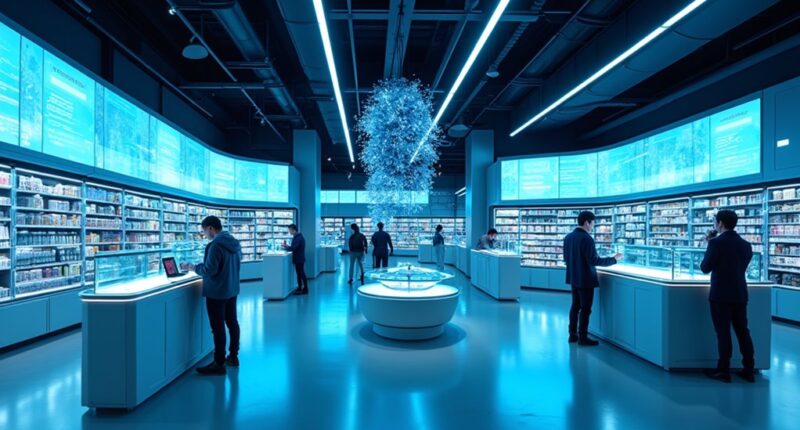AI-to-AI trade is transforming retail into a self-operating ecosystem by enabling machines to make decisions, optimize operations, and adapt seamlessly across physical and digital channels. This autonomous approach improves responsiveness, enhances personalization, and streamlines supply chains. By integrating edge computing with cloud insights, retailers can better forecast demand and manage inventory in real time. Keep exploring to discover how this innovation can reshape your retail strategies and boost competitive advantage.
Key Takeaways
- AI-to-AI trade enables autonomous decision-making, optimizing retail operations without human intervention.
- It fosters continuous ecosystem learning, improving inventory, demand forecasting, and customer engagement.
- Seamless communication between AI systems creates a self-sustaining retail environment that adapts in real-time.
- This synergy enhances scalability, resilience, and efficiency across physical and digital retail channels.
- Human oversight remains crucial, but AI-to-AI interactions drive the ecosystem toward self-operating capabilities.

As retail evolves, AI is transforming the industry into a self-operating ecosystem by seamlessly integrating edge computing with cloud technologies. This hybrid AI approach isn’t just about deploying individual tools; it’s about creating a cohesive infrastructure where real-time data processing at the edge combines with the expansive insights of cloud intelligence. This synergy allows you to deliver faster, more personalized shopping experiences while scaling operations efficiently during peak times. Instead of chasing the latest AI breakthroughs, your focus shifts to maximizing this ecosystem—ensuring that every component works together smoothly to meet customer expectations and business goals. Ecosystem convergence of these technologies fundamentally determines AI success at scale in retail environments. Hybrid AI enables your retail operations to be both agile and scalable. During busy seasons, this architecture supports rapid decision-making and inventory adjustments, helping you respond swiftly to changing demand. By processing critical data locally at the store or warehouse edge, you reduce latency and improve responsiveness. Meanwhile, cloud-based systems analyze broader trends and update AI models continuously, keeping your platform current without constant manual intervention. This balance between edge and cloud allows your retail environment to be more resilient, adaptable, and efficient, especially in omnichannel settings where over 45% of sales in 2024 involve multiple channels. AI-driven personalization plays a pivotal role in enhancing customer experiences across all touchpoints. You can leverage vast consumer data and machine learning to craft tailored recommendations, creating a shopping journey that feels seamless whether online or in-store. High refresh rates in AI-driven systems can significantly enhance customer interactions. Voice assistants and chatbots become more intuitive, offering support that’s quick and natural, regardless of the channel. In warehouses, AI-powered robots sort and pack goods faster and more accurately, reducing errors and operational costs. Visual recognition AI helps identify counterfeit products, ensuring your brand’s integrity stays intact, while AI-generated content boosts your website’s SEO, attracting more shoppers and increasing engagement. In physical stores, AI enhances customer interactions by analyzing behavior, optimizing layouts, and predicting demand. Sensors and mobile data help refine how you stock shelves and serve customers, making each visit more personalized and efficient. AI-driven demand forecasting becomes essential for maintaining ideal inventory levels amid fierce competition, keeping products available without overstocking. These applications help your retail operation stay agile and responsive, adapting quickly to market shifts and customer preferences. At its core, AI unifies your physical and digital retail environments into a cohesive system capable of tackling complex future demands. It supports demand forecasting, logistics, and risk management, aligning your investments with evolving consumer expectations. While generative AI opens new possibilities, human input remains crucial to fully realize its potential. Delaying digital transformation risks devaluing your retail brand, forcing you into a price-driven race rather than offering differentiated, value-added experiences. By embracing this AI-to-AI trade, you create a self-operating retail ecosystem that’s more efficient, responsive, and poised for growth.
Frequently Asked Questions
How Does Ai-To-Ai Trading Ensure Data Security?
You guarantee data security in AI-to-AI trading by encrypting all data at rest and in transit, using strong standards like TLS 1.3. You limit access with multi-factor authentication and role-based controls, actively monitor logs for suspicious activity, and verify data integrity with digital signatures and checksums. Additionally, you track data provenance, employ anomaly detection, and adapt security policies in real time to protect your trading ecosystem from threats.
Can Small Retailers Implement Ai-To-Ai Systems Easily?
Yes, small retailers can implement AI-to-AI systems more easily now thanks to no-code and low-code platforms that simplify setup. Cloud-based services reduce infrastructure needs, making integration smoother. Start small with targeted projects like inventory management, then expand gradually. While costs and technical skills can be barriers, partnering with AI consultants and investing in staff training helps overcome these challenges, making AI-to-AI adoption feasible for small businesses.
What Are the Initial Costs of Transitioning to This Ecosystem?
You’re looking at a significant investment to switch into this self-operating ecosystem. Initial costs include AI software licenses, which can range from $5,000 to over $200,000, plus hardware like GPUs, infrastructure upgrades, and cybersecurity measures. Development and integration expenses might exceed expectations, especially for legacy system compatibility. Small retailers could start with off-the-shelf tools costing a few thousand, but larger setups require substantial upfront capital and ongoing investments.
How Does Ai-To-Ai Handle Inventory Management?
AI-to-AI handles inventory management by automating stock updates, stocktaking, and discrepancy detection in real-time. It uses machine learning to forecast demand accurately, considering external factors and seasonal trends. The system manages inventory across multiple locations, streamlines reordering, and triggers replenishments automatically. You’ll see fewer errors, reduced waste, and improved product availability, ensuring your inventory stays optimized and responsive to market changes without manual intervention.
What Are Potential Risks of an Autonomous Retail Ecosystem?
They say “trust, but verify,” and that’s vital here. Your autonomous retail ecosystem faces cybersecurity threats like data breaches and insider attacks, risking customer privacy. Technical issues such as system malfunctions or delays can hurt your operations and customer experience. Additionally, social risks like job displacement and ethical concerns around AI bias and privacy could damage your reputation. To succeed, you must prioritize security, transparency, and responsible AI management.
Conclusion
You might wonder if AI-to-AI trade could replace human touch, but it actually enhances your shopping experience by making it more seamless and efficient. Instead of replacing people, it empowers retailers to better anticipate your needs and deliver personalized service faster. Embracing this technology means you get smarter, quicker, and more tailored shopping every time. So, rather than fear automation, see it as a way to enjoy a smarter, more responsive retail world designed around you.









